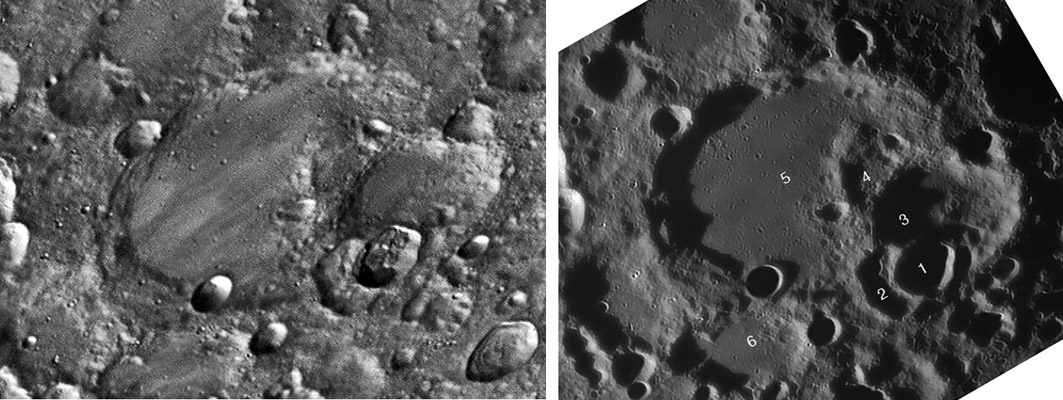Difference between revisions of "May 9, 2013"
| Line 4: | Line 4: | ||
<!-- ws:start:WikiTextHeadingRule:0:<h1> --> | <!-- ws:start:WikiTextHeadingRule:0:<h1> --> | ||
<!-- ws:start:WikiTextLocalImageRule:6:<img src="http://lpod.wikispaces.com/file/view/LPOD-May9-13.jpg/430059638/LPOD-May9-13.jpg" alt="" title="" /> -->[[File:LPOD-May9-13.jpg|LPOD-May9-13.jpg]]<!-- ws:end:WikiTextLocalImageRule:6 --><br /> | <!-- ws:start:WikiTextLocalImageRule:6:<img src="http://lpod.wikispaces.com/file/view/LPOD-May9-13.jpg/430059638/LPOD-May9-13.jpg" alt="" title="" /> -->[[File:LPOD-May9-13.jpg|LPOD-May9-13.jpg]]<!-- ws:end:WikiTextLocalImageRule:6 --><br /> | ||
| − | <em>left image by [mailto:digital.astronomy@gmail.com Pete Lawrence] & right image by [http://lpod. | + | <em>left image by [mailto:digital.astronomy@gmail.com Pete Lawrence] & right image by [http://www2.lpod.org/wiki/October_16,_2007 Bob Pilz]</em><br /> |
<br /> | <br /> | ||
| − | Mostly we observe features near the terminator because the shadows dramatically exaggerate topographic roughness. Bob's image at right from a 2007 [http://lpod. | + | Mostly we observe features near the terminator because the shadows dramatically exaggerate topographic roughness. Bob's image at right from a 2007 [http://www2.lpod.org/wiki/October_16,_2007 LPOD] is a wonderful example. But high Sun imaging, as Pete illustrates at left, provides additional information. Pete's image is a negative view, with bright areas being dark and vice-versa. I like this pair because the more commonly observed right view only hints at what becomes obvious when the high Sun is higher: Stöffler is broadly covered by rays from Tycho. If you can remember that rays appear dark in the negative image you will see two to three streamers across the middle of the crater floor, and a large splash of rays near the top. On Bob's low Sun image the top splash is an area of numerous impact craters, probably mostly Tycho secondaries. Look closely at the rays and notice pits long them; the 100 m resolution of the LRO [http://target.lroc.asu.edu/da/qmap.html?mv=eqc&mcx=172031.54192&mcy=-1243996.15457&mz=7 QuickMap] shows many more smaller craters along the rayed areas. Whenever I look at a modest to high illumination image, especially of maria, I often strongly enhance the contrast to detect faint rays. It is surprising that most places on the Moon seem to be veneered with rays, whose source craters are often indeterminant. This means that at diameters below about 1 km, secondary pits are nearly everywhere.<br /> |
<br /> | <br /> | ||
<em>[mailto:tychocrater@yahoo.com Chuck Wood]</em><br /> | <em>[mailto:tychocrater@yahoo.com Chuck Wood]</em><br /> | ||
| Line 15: | Line 15: | ||
<strong>Related Links</strong><br /> | <strong>Related Links</strong><br /> | ||
Rükl plate [https://the-moon.us/wiki/R%C3%BCkl_65 65]<br /> | Rükl plate [https://the-moon.us/wiki/R%C3%BCkl_65 65]<br /> | ||
| − | <em>[ | + | <em>[[21st Century Atlas of the Moon|21st Century Atlas]]</em> chart 14.<br /> |
<br /> | <br /> | ||
<p><b>Yesterday's LPOD:</b> [[May 8, 2013|Mortified Faults]] </p> | <p><b>Yesterday's LPOD:</b> [[May 8, 2013|Mortified Faults]] </p> | ||
Latest revision as of 08:33, 28 October 2018
Positive About Negative

left image by Pete Lawrence & right image by Bob Pilz
Mostly we observe features near the terminator because the shadows dramatically exaggerate topographic roughness. Bob's image at right from a 2007 LPOD is a wonderful example. But high Sun imaging, as Pete illustrates at left, provides additional information. Pete's image is a negative view, with bright areas being dark and vice-versa. I like this pair because the more commonly observed right view only hints at what becomes obvious when the high Sun is higher: Stöffler is broadly covered by rays from Tycho. If you can remember that rays appear dark in the negative image you will see two to three streamers across the middle of the crater floor, and a large splash of rays near the top. On Bob's low Sun image the top splash is an area of numerous impact craters, probably mostly Tycho secondaries. Look closely at the rays and notice pits long them; the 100 m resolution of the LRO QuickMap shows many more smaller craters along the rayed areas. Whenever I look at a modest to high illumination image, especially of maria, I often strongly enhance the contrast to detect faint rays. It is surprising that most places on the Moon seem to be veneered with rays, whose source craters are often indeterminant. This means that at diameters below about 1 km, secondary pits are nearly everywhere.
Chuck Wood
Technical Details
Lawrence image: April 20, 2013, 21:20. C-14 + PGR Flea-3 at the prime focus; small piece of a 213 hand-stitched panes - full zoomable scene here.
Related Links
Rükl plate 65
21st Century Atlas chart 14.
Yesterday's LPOD: Mortified Faults
Tomorrow's LPOD: Rilles And More
COMMENTS?
Register, Log in, and join in the comments.



